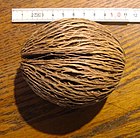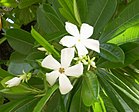Note: This is a project under development. The articles on this wiki are just being initiated and broadly incomplete. You can Help creating new pages.
Difference between revisions of "Cerbera odollam - Auddalaka"
(→External Links) |
(→Common names) |
||
| (6 intermediate revisions by 2 users not shown) | |||
| Line 1: | Line 1: | ||
[[File:Cerbera odollum - IMG 1463.jpg|thumb|right|''Auddalaka'', ''Cerbera odollam'']] | [[File:Cerbera odollum - IMG 1463.jpg|thumb|right|''Auddalaka'', ''Cerbera odollam'']] | ||
| − | '''Auddalaka''' | + | '''Auddalaka''' is a small tree found along coasts in tropical countries. All parts of the tree yield a potent poison, especially the milky latex which copiously exudes from the stems. |
| − | |||
==Uses== | ==Uses== | ||
{{Uses|Skin diseases}}, {{Uses|Ringworm}}, {{Uses|Rabies}} | {{Uses|Skin diseases}}, {{Uses|Ringworm}}, {{Uses|Rabies}} | ||
| Line 12: | Line 11: | ||
==Common names== | ==Common names== | ||
| − | {{Common names|kn= | + | {{Common names|kn=Chande, Chende hoo|ml=Otavalam, Othalam, Chattankaya|sa=Auddalakah, Svanamarah|ta=Kadalma, Udalai|te=|hi=Dabur, Pilikirbir, Sukanu|en=Sea Mango}} |
<ref name="Common names"/> | <ref name="Common names"/> | ||
| Line 36: | Line 35: | ||
==Identification== | ==Identification== | ||
===Leaf=== | ===Leaf=== | ||
| − | {{Leaf|Simple| | + | {{Leaf|Simple|Alternate, clustered at ends|Petiole 8-35 mm long, slender, glabrous; lamina 10-25 x 2.5-6.5 cm, lanceolate or oblanceolate; base cuneate or attenuate.}}<ref name="Leaf"/> |
===Flower=== | ===Flower=== | ||
| − | {{Flower|Bisexual| | + | {{Flower|Bisexual|Axillary spiciform racemes|Pseudoterminal cymes|White|5|5 cm across, white, in pseudoterminal cymes; calyx lobes 5, linear, recurved, eglandular.}} |
===Fruit=== | ===Fruit=== | ||
| − | {{Fruit|A drupe|| | + | {{Fruit|A drupe||Globose or ellipsoid, pericarp green turning rose; seeds 1 or 2 compressed.||}} |
===Other features=== | ===Other features=== | ||
| Line 55: | Line 54: | ||
==How to plant/cultivate== | ==How to plant/cultivate== | ||
| − | + | Seeds left in a bowl of warm water will start sprouting. | |
| − | = | + | <ref name="Cultivation details"/> |
| − | |||
| − | |||
| − | |||
| − | |||
| − | |||
==Commonly seen growing in areas== | ==Commonly seen growing in areas== | ||
| Line 84: | Line 78: | ||
<ref name="Leaf">[http://FLOWERING PLANTS OF KERALA VER.2, N. Sasidharan "BOTANIC DESCRIPTION"]</ref> | <ref name="Leaf">[http://FLOWERING PLANTS OF KERALA VER.2, N. Sasidharan "BOTANIC DESCRIPTION"]</ref> | ||
<ref name="Common names">[http://envis.frlht.org/bot_search "Vernacular names"]</ref> | <ref name="Common names">[http://envis.frlht.org/bot_search "Vernacular names"]</ref> | ||
| − | + | <ref name="Cultivation details">[http://www.culture-acre.com/surprising-tropical-plant-cerbera-odollam-suicide-tree/ "Cultivation details"]</ref> | |
</references> | </references> | ||
Latest revision as of 12:29, 6 October 2020
Auddalaka is a small tree found along coasts in tropical countries. All parts of the tree yield a potent poison, especially the milky latex which copiously exudes from the stems.
Contents
- 1 Uses
- 2 Parts Used
- 3 Chemical Composition
- 4 Common names
- 5 Properties
- 6 Habit
- 7 Identification
- 8 List of Ayurvedic medicine in which the herb is used
- 9 Where to get the saplings
- 10 Mode of Propagation
- 11 How to plant/cultivate
- 12 Commonly seen growing in areas
- 13 Photo Gallery
- 14 References
- 15 External Links
Uses
Skin diseases, Ringworm, Rabies [1]
Parts Used
Chemical Composition
Common names
| Language | Common name |
|---|---|
| Kannada | Chande, Chende hoo |
| Hindi | Dabur, Pilikirbir, Sukanu |
| Malayalam | Otavalam, Othalam, Chattankaya |
| Tamil | Kadalma, Udalai |
| Telugu | |
| Marathi | NA |
| Gujarathi | NA |
| Punjabi | NA |
| Kashmiri | NA |
| Sanskrit | Auddalakah, Svanamarah |
| English | Sea Mango |
Properties
Reference: Dravya - Substance, Rasa - Taste, Guna - Qualities, Veerya - Potency, Vipaka - Post-digesion effect, Karma - Pharmacological activity, Prabhava - Therepeutics.
Dravya
Rasa
Tikta (Bitter), Katu (Pungent)
Guna
Laghu (Light), Rooksha (Dry)
Veerya
Ushna (Hot)
Vipaka
Karma
Vata
Prabhava
Habit
Identification
Leaf
| Kind | Shape | Feature |
|---|---|---|
| Simple | Alternate, clustered at ends | Petiole 8-35 mm long, slender, glabrous; lamina 10-25 x 2.5-6.5 cm, lanceolate or oblanceolate; base cuneate or attenuate. |
Flower
| Type | Size | Color and composition | Stamen | More information |
|---|---|---|---|---|
| Bisexual | Axillary spiciform racemes | Pseudoterminal cymes | White | 5 |
Fruit
| Type | Size | Mass | Appearance | Seeds | More information |
|---|---|---|---|---|---|
| A drupe | Globose or ellipsoid, pericarp green turning rose; seeds 1 or 2 compressed. | {{{6}}} |
Other features
List of Ayurvedic medicine in which the herb is used
Where to get the saplings
Mode of Propagation
How to plant/cultivate
Seeds left in a bowl of warm water will start sprouting. [4]
Commonly seen growing in areas
Photo Gallery
References
External Links
Categories:
- Ayurvedic Herbs known to be helpful to treat Skin diseases
- Ayurvedic Herbs known to be helpful to treat Ringworm
- Ayurvedic Herbs known to be helpful to treat Rabies
- Herbs with Bark used in medicine
- Herbs with Fruits used in medicine
- Herbs with Leaves used in medicine
- Herbs with Latex used in medicine
- Herbs with common name in Kannada
- Herbs with common name in Hindi
- Herbs with common name in Malayalam
- Herbs with common name in Tamil
- Herbs with common name in Sanskrit
- Herbs with common name in English
- Habit - Small tree
- Index of Plants which can be propagated by Seeds
- Index of Plants which can be propagated by Cuttings
- Herbs that are commonly seen in the region of Tropical area
- Herbs that are commonly seen in the region of Coastal area
- Herbs
- Coastal area
- Tree
- Apocynaceae





